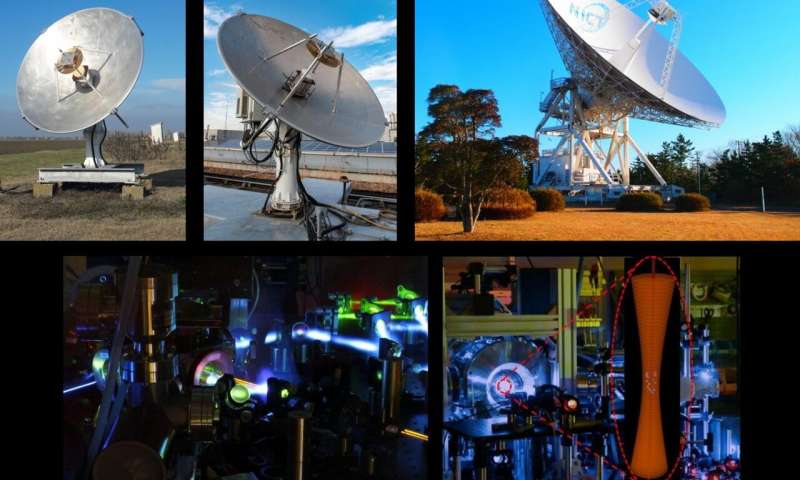HOME
Signals from distant stars connect optical atomic clocks across Earth for the first time

Antennas and optical lattice clocks used. Upper left: 2.4 m antenna installed at INAF, Italy. Upper middle: 2.4 m antenna installed at NICT, Japan. Upper right: 34 m antenna located at NICT, Japan. Bottom left: The ytterbium optical lattice clock operated at INRIM, Italy. Bottom right: The strontium optical lattice clock located at NICT, Japan. Credit: National Institute of Information and Communications Technology (NICT), except bottom left. Credit: Istituto Nazionale di Ricerca Metrologica (INRIM))
Using radio telescopes observing distant stars, scientists have connected optical atomic clocks on different continents. The results were published in the scientific journal Nature Physics by an international collaboration between 33 astronomers and clock experts at the National Institute of Information and Communications Technology (NICT, Japan), the Istituto Nazionale di Ricerca Metrologica (INRIM, Italy), the Istituto Nazionale di Astrofisica (INAF, Italy), and the Bureau International des Poids et Mesures (BIPM, France).
The BIPM in Sèvres near Paris routinely calculates the international time recommended for civil use (UTC, Coordinated Universal Time) from the comparison of atomic clocks via satellite communications. However, the satellite connections that are essential to maintaining a synchronized global time have not kept up with the development of new atomic clocks: Optical clocks that use lasers interacting with ultracold atoms to give a very refined ticking. "To receive the full benefit of optical clocks in UTC, it is important to improve worldwide clock comparison methods," said Gérard Petit, physicist at the Time Department at BIPM.
In this new research, highly-energetic extragalactic radio sources replace satellites as the source of reference signals. The group of Sekido Mamoru at NICT designed two special radio telescopes, one deployed in Japan and the other in Italy, to realize the connection using the technique of Very Long Baseline Interferometry (VLBI). These telescopes are capable of observations over a large bandwidth, while antenna dishes of just 2.4 meter diameter keep them transportable. "We want to show that broadband VLBI has potential to be a powerful tool not only for geodesy and astronomy, but also for metrology." commented Sekido. To reach the required sensitivity, the small antennas worked in tandem with a larger 34 m radio telescope in Kashima, Japan during the measurements taken from October 14 2018 to February 14 2019. For the Kashima radio telescope, these were among the last observations before the telescope was irreparably damaged by typhoon Faxai in September 2019.
News Source